Navigation/Menü: Links auf weitere Seiten dieser Website und Banner
12.02.2007
HRSC Press Release #315 - HRSC Maps
Cartography with HRSC on Mars Express - the Iani Chaos Region
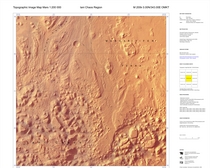 #1 Topographic Image Map M 200k 0.00N/343.00E 1:200,000 |
These map sheets of the Martian Iani Chaos region are based on image data obtained with the High Resolution Stereo Camera (HRSC), under the leadership of the Principal Investigator Prof. Dr. Gerhard Neukum of Freie Universitaet Berlin, onboard the ESA spacecraft Mars Express. The camera experiment provides excellent color and 3D data, which are well suited to derive large-scale map products of high quality. The map sheets and scenes shown here were processed by the Institute for Geodesy and Geoinformation Science (Prof. J. Albertz, S. Gehrke), Technische Universität Berlin, in cooperation with the German Aerospace Center (DLR), Institute of Planetary Research, Berlin.
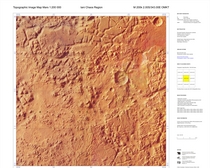 #2 Topographic Image Map M 200k 2.00S/343.00E 1:200,000 |
Designed as a possible standard map series for the HRSC experiment onboard the Mars Express mission was the "Topographic Image Map Mars 1:200,000". So far all map sheets would be based on HRSC orthoimage mosaics and show contour lines derived from HRSC Digital Terrain Models (DTMs). Furthermore, they feature Martian topographic names (craters, mountains, valleys, etc.), cartographic graticules, sheet names, individual designations, and all respective legend entries. Up to now, some exemplary map sheets have been created within the scope of the German HRSC experiment funding. A realization of the map series could only be carried out within a currently discussed comprehensive effort towards a planetary mapping program at European level.
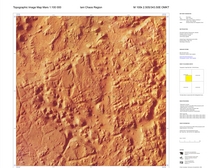 #3 Topographic Image Map M 100k 2.50S/343.50E 1:100,000 |
Should the outlined map series be realized, the planet Mars would be covered by 10,372 particular map sheets in equal-area map projections - 10,324 of them within the ±85° latitude zone in Sinusoidal Projection, supplemented by 48 polar sheets in Lambert Azimuthal Equal-area Projection. While each of the quadrangles spans 2° in latitude, longitudinal extents increase from 2° near the equator up to 360° toward the poles in order to keep the mapped area approximately constant. Therefore, the general layout of all maps appears very similar; each sheet features an overall width of 830 mm and a height of 700 mm.
![Context Map [2]](./preleases/315/thumbs/315-021106-6-ctxt-IaniChaosMaps.jpg) Context Map [2] |
The sheets of such a "Topographic Image Map Mars 1:200,000" standard series as outlined here can be subdivided into quarters and sixteenths for systematic cartography in larger scales 1:100,000 and 1:50,000, respectively. In principle, the cartographic concept perfectly meets all requirements for mapping specific Martian surface features or regions of interest. To illustrate the quality of HRSC images and DTMs as well as the cartographic concept and the flexibility of the outlined map series, several exemplary sheets of the Martian Iani Chaos region in different scales have been generated. Iani Chaos is a large depression with dimensions of 330 km in length and 430 km in width, located at 2.8° south and 342.5° east (see context map). Individual blocks of rock and hills form a disrupted, knobby pattern in an apparently "chaotic" distribution. Terraces and "islands" are likely remnants of the pre-existing surface, which collapsed after cavities had formed beneath it - ice in these cavities might have been melted by volcanic heat and flowed into Ares Vallis towards the northern lowlands (cp. HRSC press release #182, 2005). Due to the hints of water having formed it, such a landscape is of special geological interest but it is also well suited to present the design and the potential of the topographic map series.
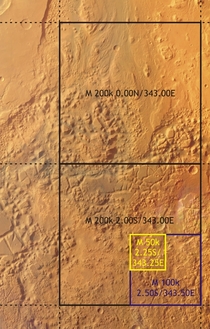 Context Map |
Iani Chaos was covered within the orbits 0912, 0923, and 0934 with best possible ground resolutions. In this area, two adjacent map products within the regular sheet lines of the outlined "Topographic Image Map Mars 1:200,000" standard series, "M 200k 0.00N/343.00E OMKT" and "M 200k 2.00S/343.00E OMKT" (Sheets #1 & #2) as well as several subdividing maps in larger scales, i.e., 1:100,000 (example Sheet #3) and 1:50,000 (example Sheet #4) have been produced. While the maps feature their individual designations, all of them are named "Iani Chaos Region". Within their mapped surfaces, the sheets differ in image resolution due to their different scales. Although few effects of image compression are recognizable in the largest scale (cp. Sheet #4, e.g., at shadowed slopes), in general more texture details of the Martian surface become visible. A contour line equidistance of 250 m is common for most of the sheets of the 1:200,000 topographic maps. In larger scales, a more subtle representation of the terrain topography is achieved by denser contour lines.
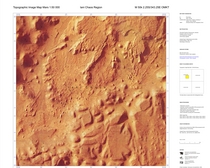 #4 Topographic Image Map M 50k 2.25S/343.25E 1:50,000 |
All map sheets have been generated using the cartographic software system "Planetary Image Mapper" (PIMap), which has been developed at Technische Universität Berlin for cartographic presentation of HRSC data. Topographic map contents, graticules, frame lines, map titles as well as typical marginal elements can be generated and/or combined to the digital map sheet with PIMap. The software is flexible with regard to map scales, contour line layout, or sheet contents in general.
Das Kameraexperiment HRSC auf der Mission Mars Express der
Europäischen Weltraumorganisation ESA wird vom Principal Investigator Prof. Dr.
Gerhard Neukum (Freie Universität Berlin), der auch die technische Konzeption der
hochauflösenden Stereokamera entworfen hatte, geleitet. Das
Wissenschaftsteam besteht aus 40 Co-Investigatoren aus 33 Institutionen und zehn
Nationen. Die Kamera wurde am Deutschen Zentrum für Luft- und Raumfahrt (DLR) unter der
Leitung des Principal Investigators (PI) G. Neukum entwickelt und in Kooperation mit
industriellen Partnern gebaut (EADS Astrium, Lewicki Microelectronic GmbH und Jena
-Optronik GmbH). Sie wird vom DLR -Institut für Planetenforschung in Berlin-Adlershof
betrieben. Die systematische Prozessierung der Daten erfolgt am DLR. Die Darstellungen
wurden vom Institut für Geologische Wissenschaften der FU Berlin in Zusammenarbeit
mit dem DLR-Institut für Planetenforschung erstellt.
The High Resolution Stereo Camera (HRSC) experiment on the ESA Mars Express Mission is led by the
Principal Investigator (PI) Prof. Dr. Gerhard Neukum who also designed the camera technically. The
science team of the experiment consists of 40 Co-Investigators from 33 institutions and 10 nations.
The camera was developed at the German
Aerospace Center (DLR) under
the leadership of the PI G. Neukum and built in cooperation with industrial partners (EADS
Astrium, Lewicki Microelectronic GmbH and Jena-Optronik GmbH). The experiment on Mars Express
is operated by the DLR Institute of Planetary Research, through ESA/ESOC. The systematic
processing of the HRSC image data is carried out at DLR. The scenes shown here were created
by the PI-group at the Institute for Geological Sciences of the Freie Universitaet Berlin in
cooperation with the German Aerospace Center (DLR), Institute of Planetary Research, Berlin.
Download
hochaufgelöste Bilddaten / high resolution image data
| Context Map [2]: |
| Context Map: |
| #1 Topographic Image Map M 200k 0.00N/343.00E 1:200,000: |
| #2 Topographic Image Map M 200k 2.00S/343.00E 1:200,000: |
| #3 Topographic Image Map M 100k 2.50S/343.50E 1:100,000: |
| #4 Topographic Image Map M 50k 2.25S/343.25E 1:50,000: |
© Copyright: ESA/DLR/FU Berlin (G. Neukum)

 Deutsch
Deutsch

